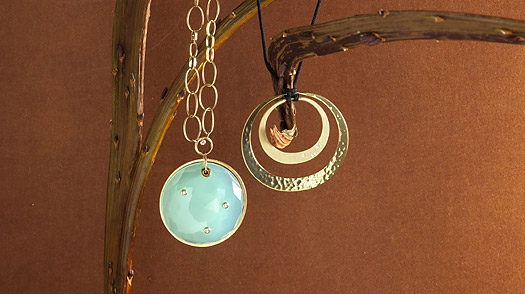
(2 of 2)
Traditionally, the source of stones has been hard to confirm, since they change hands so many times in their travels from the mine to the manufacturer. But certified conflict-free diamonds and other precious stones are now easier to come by.
Kathy Rose, a Los Angeles—based jewelry designer and owner of Roseark, a fine-art and jewelry gallery in West Hollywood that's a -favorite shopping spot for Demi Moore and Charlize Theron, also uses conflict-free diamonds in her work. "When I have a diamond in my hand, I can feel the frequency of where it came from," she says. "And the cut of a diamond matters too. I use a lot of rose-cut diamonds because it's not as wasteful [to create that shape from a rough diamond]. You definitely don't blow out a village for a rose-cut diamond."
But Rose adds that green jewelry isn't all about recycled metals and ethical diamonds. Many of the designers she carries at Roseark are using materials like wood, feathers and vintage charms to create pieces with little environmental impact. "For her Mannin line, designer Suzanne Donegan takes vintage pieces, many from the turn of the century, like tiny gold watch fobs, magnifying glasses and old compasses, and creates opera-length necklaces with them," says Rose. "And people are more interested in unusual stones like peridot or fire opal" that aren't affiliated with the same political troubles as diamonds.
Often what you don't use in jewelry is as important as what you do. For Ippolita, whose 18-karat-gold bangles, chains and earrings are favored by Kate Hudson and Jennifer Lopez and are available at Neiman Marcus, rare materials like coral that are harvested irresponsibly are best avoided. "We absolutely refuse to produce pieces with coral," she says. "It's obviously among the world's least renewable resources. It's incredibly inappropriate for us to do that. You can only affect what you can control. Because metal can be recycled, I feel less sensitive about it."
These environmental commitments aren't exclusive to small, independent jewelers. In fact, major brands like Cartier and Tiffany & Co. were among the founders of the Responsible Jewellery Council (RJC) in 2005. "It is our duty to provide our clients with creations that are beautiful, desirable ... and responsibly made, be it ethically, socially or environmentally," says Pamela Caillens, the corporate-responsibility director at Cartier. "As times change, so do society's expectations."
By March 2009, Cartier will be carbon-neutral, and the company -estimates that it uses 70% reclaimed gold. It is uncertain whether its clients support the Cartier brand because they share its beliefs. "We do think a lot of our customers care. But we also believe that it doesn't matter if they do or don't," says Caillens. "It's part of our job to go down that road for them."
Tiffany & Co.'s sustainability statement, which voices support for Earthworks and Oxfam and promotes its own position as a founding member of the RJC, is the most thorough and committed in the business. Tiffany is also working to pass legislation reforming the woefully outdated General Mining Law of 1872 and to assist in the cleanup of abandoned hard-rock mines. A few things about the business have changed over the past 137 years, and the next 137 will no doubt have more changes in store.
"Few people want to think of the ring on their finger, which leaves an average of 20 tons of mine waste, having such an enormous environmental and human impact," says Payal Sampat, director of the No Dirty Gold campaign. "Jewelers don't want to be associated with those images. Signing our agreement is the first step. Actually switching to responsible sources is another issue."
While using reclaimed gold is an innovative short-term solution, it's just the initial part of making the fine-jewelry industry a sustainable one. "There is not enough gold being recirculated to meet the world's demands. It's finite, and it's not the solution to this issue. Consumers, retailers — they're all waking up. This is really good for our business in terms of direction," says Pomeroy. "A lot of jewelers are now inviting people to turn their jewelry into new jewelry. There are new mining practices, like those of Canadian Mammoth Tusk Gold in the Yukon, that don't use chemicals or disturb streams. The ecology is actually stronger because of their practices."
In the end, the long-term health of both the planet and the fine-jewelry business might be determined by these very actions. "You're talking about luxury," says Pomeroy. "Well, we cannot afford the false luxury of thinking that we can continue to live this way and it will be fine."